Thursday 1st June to Friday June 16th 2017 The day before we left Nuku Hiva in the Marquesas it rained. Torrentially. In between downpours we managed to get ashore but had to shelter under the eves of the post office, using their wifi to send emails, as it started to hammer down again. So although we were sad to be leaving the beautiful Marquesas we hoped for future sunshine. Our friends on Nautilus and Jadean were heading south to Ua Pou, another of the Marquesa islands, but we needed to get on as we hoped to fit in a trip home and there were still the Tuamotus to visit on the way to Tahiti. As we left, sailing west along the north coast in force 5 to 6 winds and big seas, a rainbow arched over the island framing its rocky pinnacles. 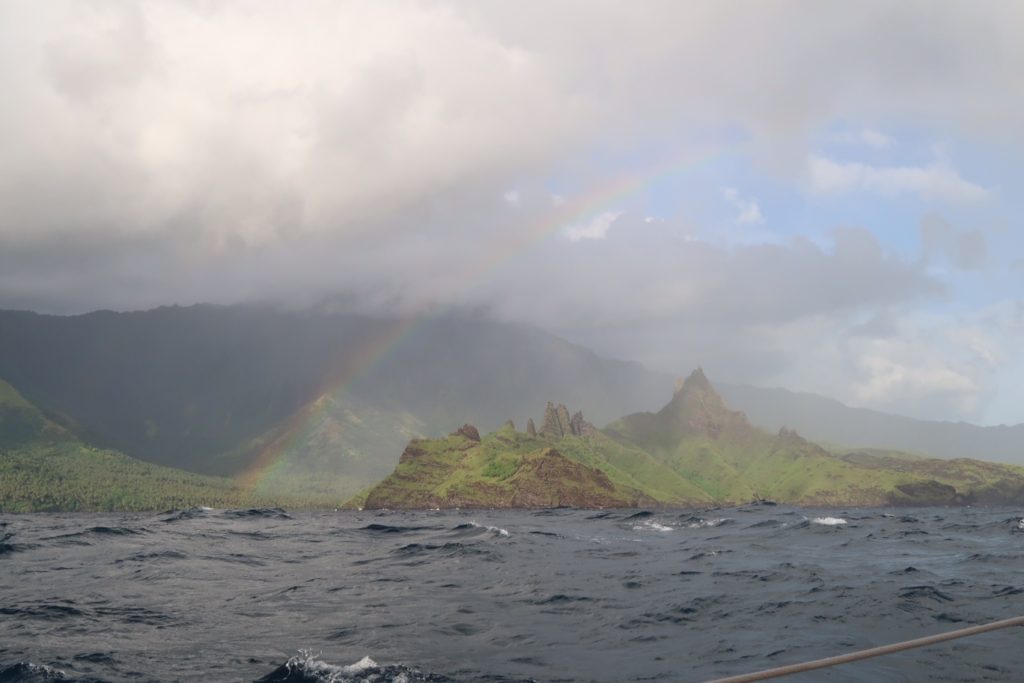 We anticipated a peaceful passage from the Marquesas to the Tuamotus, a 450 nautical mile, four day sail, but it was not to be. We had big rolling seas and strong winds with rain squalls all around, visible at night on the radar. En route we had regular emails from my brother Rob with news from the UK: stabbings in London, news of the imminent General Election, Banksy offering his prints to Bristol residents who didn’t vote Tory.
We anticipated a peaceful passage from the Marquesas to the Tuamotus, a 450 nautical mile, four day sail, but it was not to be. We had big rolling seas and strong winds with rain squalls all around, visible at night on the radar. En route we had regular emails from my brother Rob with news from the UK: stabbings in London, news of the imminent General Election, Banksy offering his prints to Bristol residents who didn’t vote Tory. 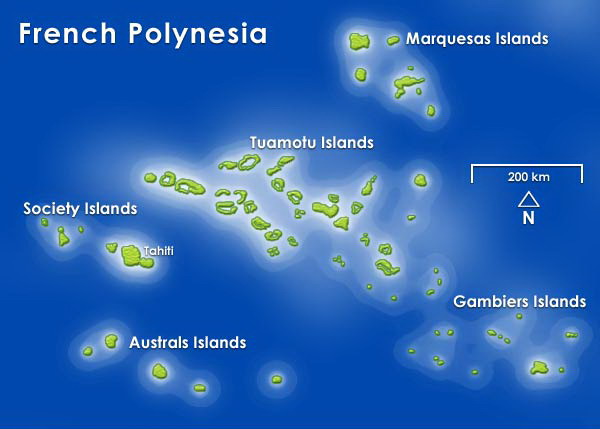 The Tuamotus (meaning the ‘Distant Islands’) are 77 low lying islands and atolls spread out over 1,500 miles across the ocean, the largest chain of atolls in the world. They used to be called the Dangerous Archipelago and were avoided by most sailing yachts which would skirt around the north of the chain on passage to Tahiti. At night and in poor visibility it was too easy to end up wrecked on one of the reefs. Thor Heyerdahl discovered this when his epic journey on the Kon-Tiki raft ended as he ran aground on Raroia in the Tuamotus. Nowadays GPS and modern navigation have made it safer to sail and to find your way between the islands. Most of them are a central lagoon surrounded by motus (islets) and reefs, some with a pass or two into the lagoon. The currents through the passes can be strong, up to 9 knots in some, and create rough overfalls especially with wind against tide. Timing is everything when entering or leaving the atolls to ensure you go through the pass near to slack water which, of course, is only every six hours. Soon after dawn on the fourth day after leaving the Marquesas we saw on the horizon the low lying atoll of Kauehi, one of the Tuamotu atolls. We could see palm trees and surf breaking on the reef surrounding the central lagoon. There is one pass into the lagoon and we had tried to find out the time of slack tide using three different sources, from the French Marine website to the times given by our Navionics electronic chart plotter. None of them agreed exactly but as we approached we could see a boat load of scuba divers preparing to do a drift dive through the pass from a 190ft super-yacht at anchor just inside the entrance, so we guessed the current was unlikely to be too strong. There were some overfalls just inside the reef but nothing Vega couldn’t easily take in her stride as we motor sailed through the pass against only a couple of knots of tide, and then sailed the 8 miles across the lagoon to the small village of Tearavero.
The Tuamotus (meaning the ‘Distant Islands’) are 77 low lying islands and atolls spread out over 1,500 miles across the ocean, the largest chain of atolls in the world. They used to be called the Dangerous Archipelago and were avoided by most sailing yachts which would skirt around the north of the chain on passage to Tahiti. At night and in poor visibility it was too easy to end up wrecked on one of the reefs. Thor Heyerdahl discovered this when his epic journey on the Kon-Tiki raft ended as he ran aground on Raroia in the Tuamotus. Nowadays GPS and modern navigation have made it safer to sail and to find your way between the islands. Most of them are a central lagoon surrounded by motus (islets) and reefs, some with a pass or two into the lagoon. The currents through the passes can be strong, up to 9 knots in some, and create rough overfalls especially with wind against tide. Timing is everything when entering or leaving the atolls to ensure you go through the pass near to slack water which, of course, is only every six hours. Soon after dawn on the fourth day after leaving the Marquesas we saw on the horizon the low lying atoll of Kauehi, one of the Tuamotu atolls. We could see palm trees and surf breaking on the reef surrounding the central lagoon. There is one pass into the lagoon and we had tried to find out the time of slack tide using three different sources, from the French Marine website to the times given by our Navionics electronic chart plotter. None of them agreed exactly but as we approached we could see a boat load of scuba divers preparing to do a drift dive through the pass from a 190ft super-yacht at anchor just inside the entrance, so we guessed the current was unlikely to be too strong. There were some overfalls just inside the reef but nothing Vega couldn’t easily take in her stride as we motor sailed through the pass against only a couple of knots of tide, and then sailed the 8 miles across the lagoon to the small village of Tearavero. 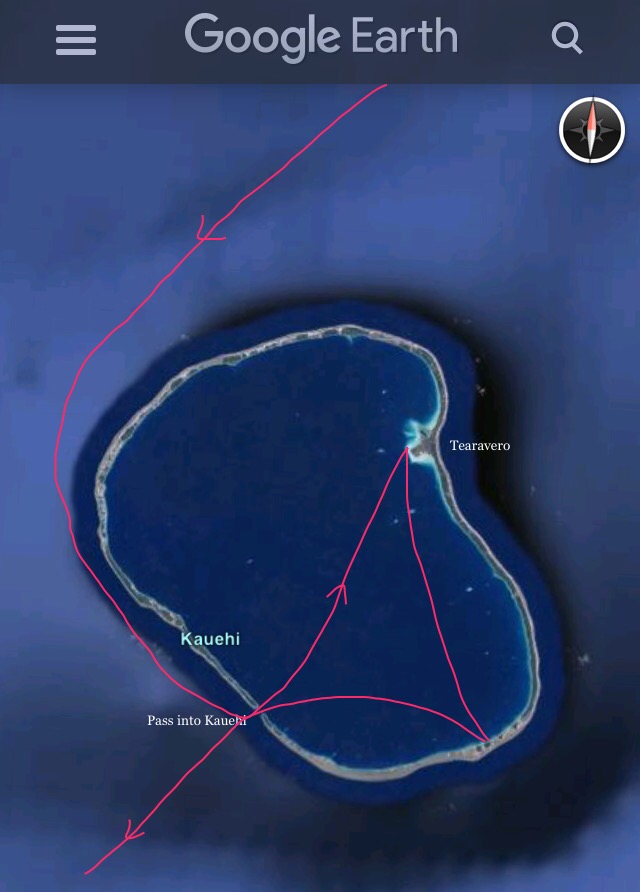 Here we dropped anchor between coral heads and took the dinghy over to the village. There is a small church, two supermarkets, a school and a graveyard at the edge of the village. As we walked down the street people were friendly, calling out ‘bonjour’. A group of women were preparing for Heiva, the festival that takes place throughout French Polynesia in July, making ornate shell necklaces to sell to the visitors that they expect to their island then. The people here make a living from fishing, copra and from pearl farming. It is a hand to mouth existence living on the Tuamotus. It looks like paradise to us but must be a hard life with only rainwater to collect for drinking and all fresh produce (other than coconuts and fish) having to be imported.
Here we dropped anchor between coral heads and took the dinghy over to the village. There is a small church, two supermarkets, a school and a graveyard at the edge of the village. As we walked down the street people were friendly, calling out ‘bonjour’. A group of women were preparing for Heiva, the festival that takes place throughout French Polynesia in July, making ornate shell necklaces to sell to the visitors that they expect to their island then. The people here make a living from fishing, copra and from pearl farming. It is a hand to mouth existence living on the Tuamotus. It looks like paradise to us but must be a hard life with only rainwater to collect for drinking and all fresh produce (other than coconuts and fish) having to be imported. 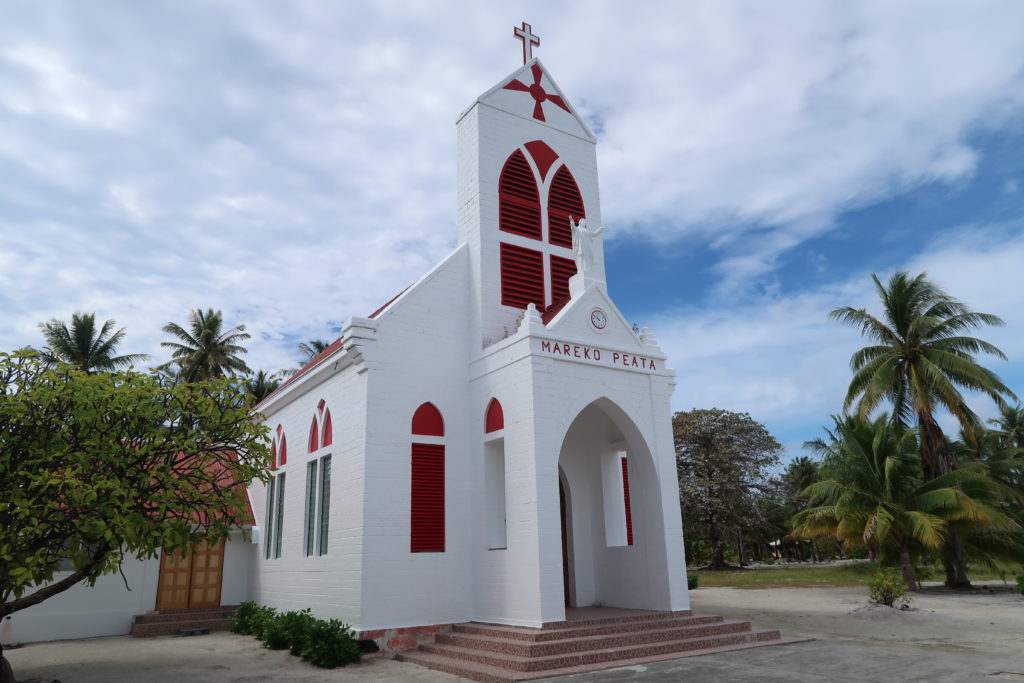
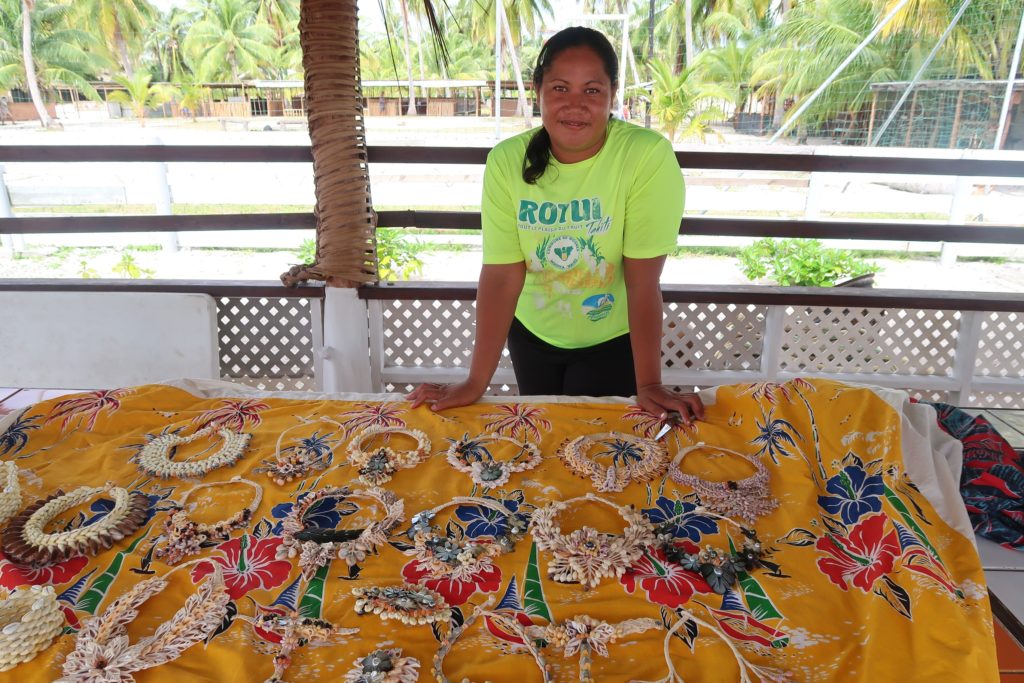
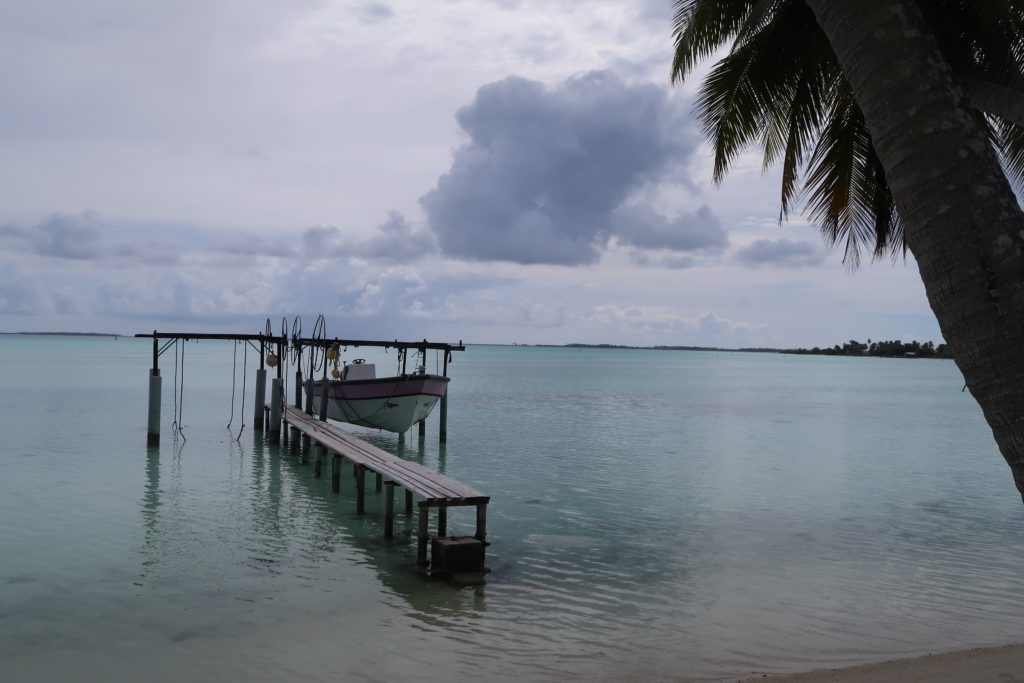
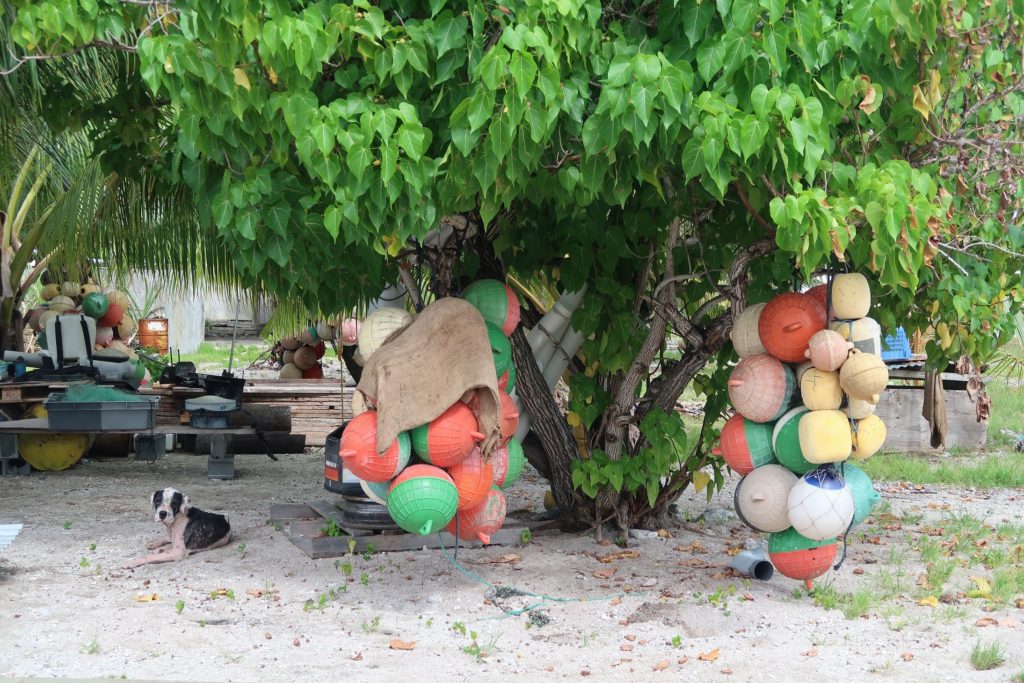 There were four other yachts at anchor by the village, including one with an Italian couple who had spent the last two years sailing around the Tuamotus, escaping to the relative safety of the Marquesas during cyclone season in the South Pacific. Hugh and I agree we would find it a bit aimless just moving around the South Pacific, beautiful though it is, though some boats do spend many years here. After one night by the village we sailed to the south of the lagoon and dropped anchor by a tiny deserted motu, covered in palm trees with a white shell beach. We were the only boat there. As the sun set it really looked like we had found our tropical paradise.
There were four other yachts at anchor by the village, including one with an Italian couple who had spent the last two years sailing around the Tuamotus, escaping to the relative safety of the Marquesas during cyclone season in the South Pacific. Hugh and I agree we would find it a bit aimless just moving around the South Pacific, beautiful though it is, though some boats do spend many years here. After one night by the village we sailed to the south of the lagoon and dropped anchor by a tiny deserted motu, covered in palm trees with a white shell beach. We were the only boat there. As the sun set it really looked like we had found our tropical paradise. 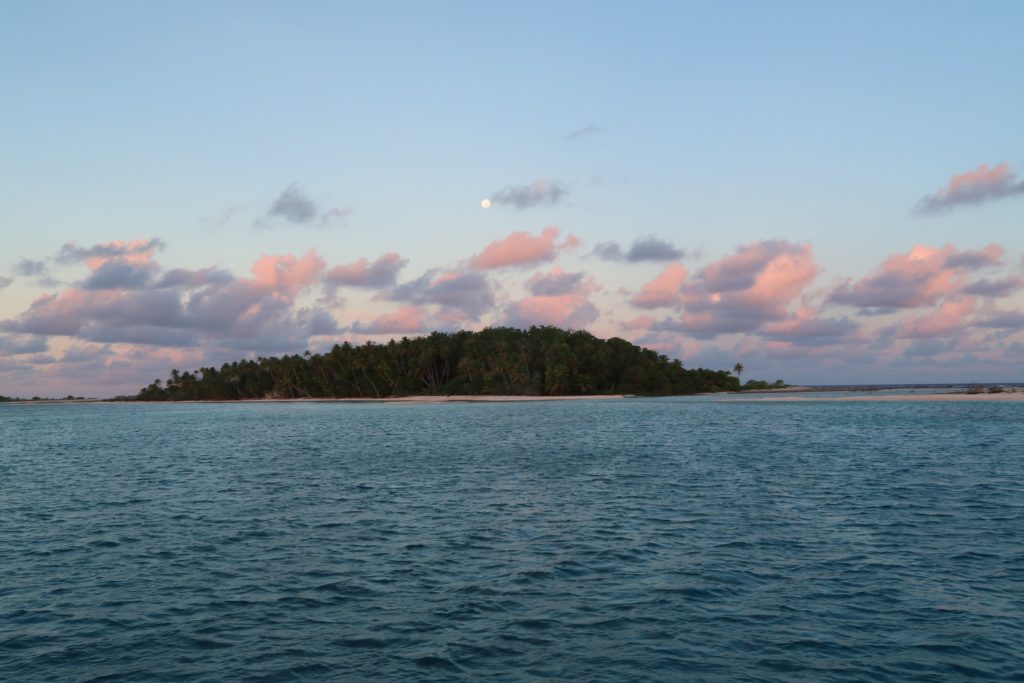 The next day we walked round the island. On the lagoon side there was pretty beach of sand and shells, palm trees, hermit crabs scuttling away as we approach, a derelict corrugated iron shack, signs of previous bonfires, small black tipped sharks swimming in the shallow pass between our island and the next one. Continuing round the island it felt rather bleak on the side exposed to the ocean: hard, dead, grey coral underfoot, trees hanging on for dear life, plastic bottles washed up from outside of the reef onto the shore.
The next day we walked round the island. On the lagoon side there was pretty beach of sand and shells, palm trees, hermit crabs scuttling away as we approach, a derelict corrugated iron shack, signs of previous bonfires, small black tipped sharks swimming in the shallow pass between our island and the next one. Continuing round the island it felt rather bleak on the side exposed to the ocean: hard, dead, grey coral underfoot, trees hanging on for dear life, plastic bottles washed up from outside of the reef onto the shore. 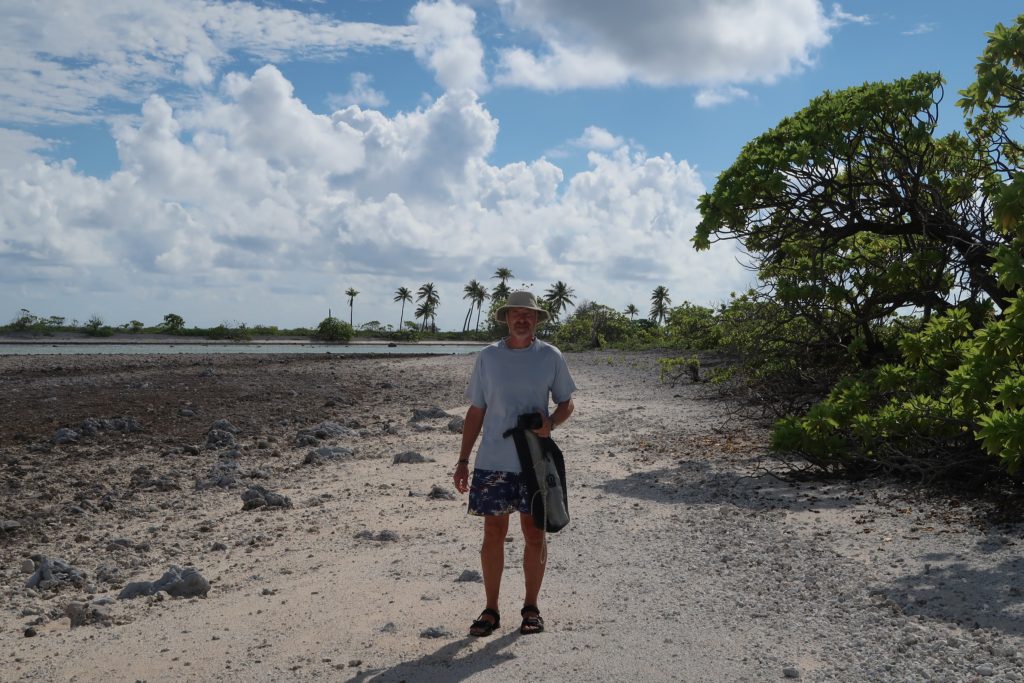
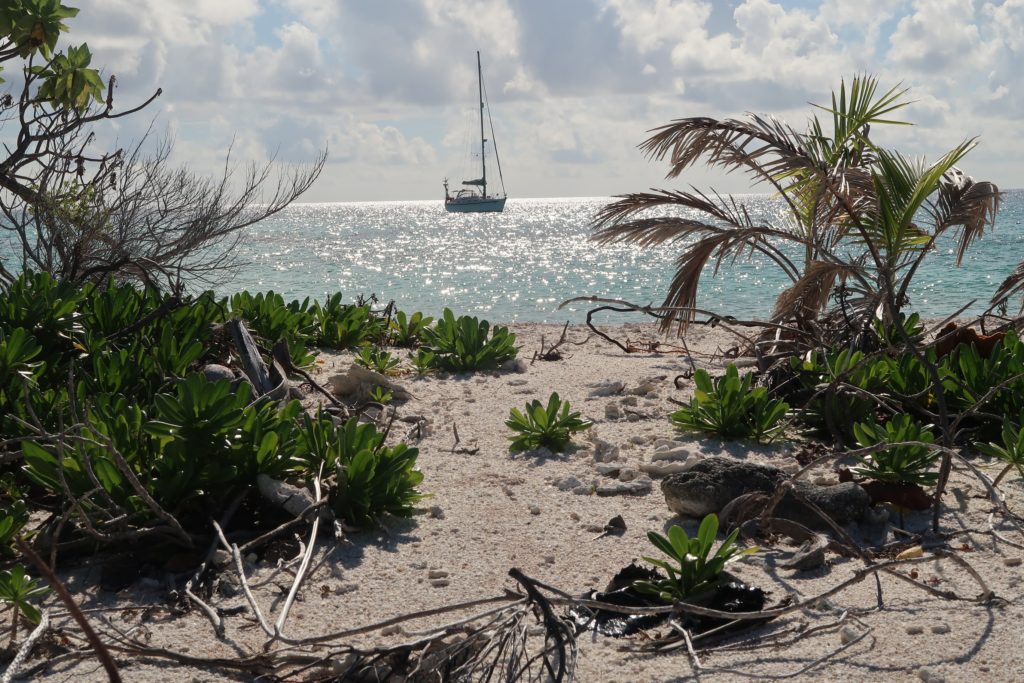 Snorkelling on the coral heads (bommies) there were huge yellow angel fish, butterfly fish, cross looking puffer fish, clams with vivid turquoise and blue lips, and brightly coloured anemones. There were also a few small sharks around but they swam away as we approached. After just a couple of nights in this idyllic spot we moved on to our next atoll, Fakarava. We were up at dawn to leave Kauehi an hour before slack water in the pass, which gave us about 7 hours to cover 39 nautical miles to reach the south pass at Fakarava in time for the next slack tide. On the way there we picked up our latest emails…. It was voting day for the General Election called by Theresa May in the UK and my brother Rob had kindly arranged proxy votes for us (thank you, Rob) so we were keen to know how things had gone, although the first results were still to come in. Fortunately the wind was steady and we arrived in good time to get through the pass and dropped anchor just inside the reef. Fakarava is the second biggest atoll in the Tuamotus, 37 miles long and 13 miles wide, and is one of the more popular to visit and one of the more populated with 806 people at the latest census, most people living in the main town, Rotoava, in the north.
Snorkelling on the coral heads (bommies) there were huge yellow angel fish, butterfly fish, cross looking puffer fish, clams with vivid turquoise and blue lips, and brightly coloured anemones. There were also a few small sharks around but they swam away as we approached. After just a couple of nights in this idyllic spot we moved on to our next atoll, Fakarava. We were up at dawn to leave Kauehi an hour before slack water in the pass, which gave us about 7 hours to cover 39 nautical miles to reach the south pass at Fakarava in time for the next slack tide. On the way there we picked up our latest emails…. It was voting day for the General Election called by Theresa May in the UK and my brother Rob had kindly arranged proxy votes for us (thank you, Rob) so we were keen to know how things had gone, although the first results were still to come in. Fortunately the wind was steady and we arrived in good time to get through the pass and dropped anchor just inside the reef. Fakarava is the second biggest atoll in the Tuamotus, 37 miles long and 13 miles wide, and is one of the more popular to visit and one of the more populated with 806 people at the latest census, most people living in the main town, Rotoava, in the north. 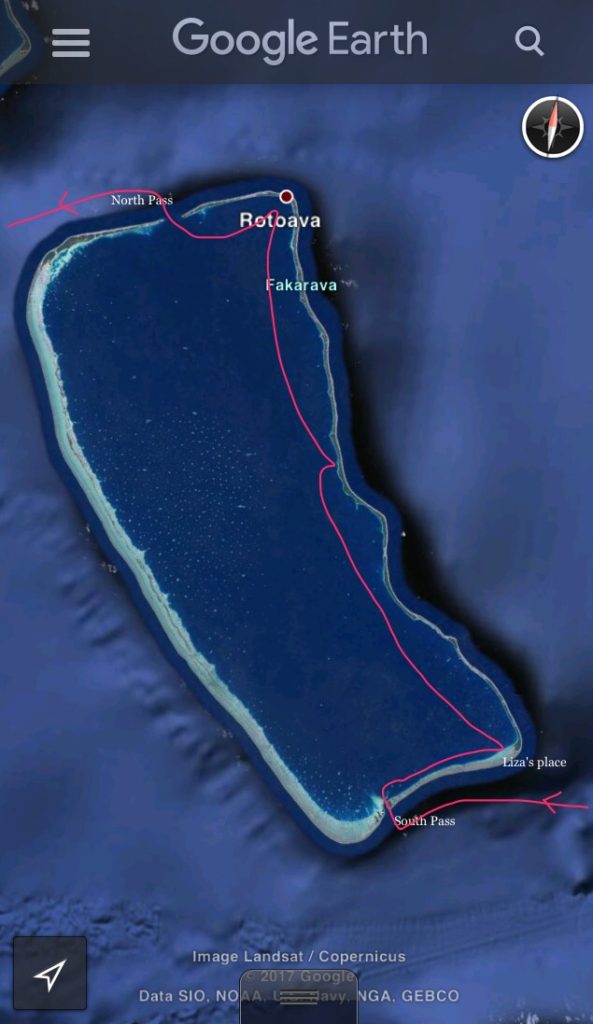 The big attraction here is the sharks and in particular the Wall of Sharks in the south pass, one of the best places in the world to swim with sharks up close. Every year at this time of year a spectacular event takes place. Thousands of groupers gather in the pass to spawn and this attracts hundreds of sharks: black tip reef sharks, nurse sharks, grey reef sharks. The sharks here are protected and Fakarava is a UNESCO Biosphere Reserve. There is a dive centre right on the corner and we dropped by the next morning to arrange a dive, and within the hour are getting geared up to join another British couple and the French dive master to do a drift dive on the pass. In the shallow water by the dive centre there are black tip reef sharks hoping for scraps from the small restaurant there.
The big attraction here is the sharks and in particular the Wall of Sharks in the south pass, one of the best places in the world to swim with sharks up close. Every year at this time of year a spectacular event takes place. Thousands of groupers gather in the pass to spawn and this attracts hundreds of sharks: black tip reef sharks, nurse sharks, grey reef sharks. The sharks here are protected and Fakarava is a UNESCO Biosphere Reserve. There is a dive centre right on the corner and we dropped by the next morning to arrange a dive, and within the hour are getting geared up to join another British couple and the French dive master to do a drift dive on the pass. In the shallow water by the dive centre there are black tip reef sharks hoping for scraps from the small restaurant there. 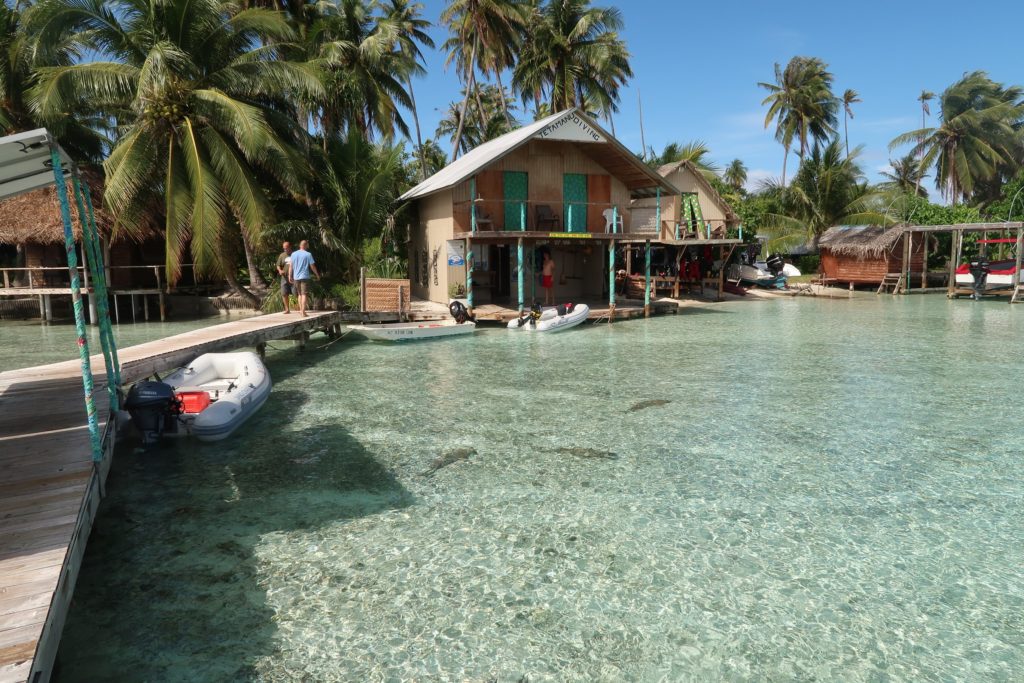
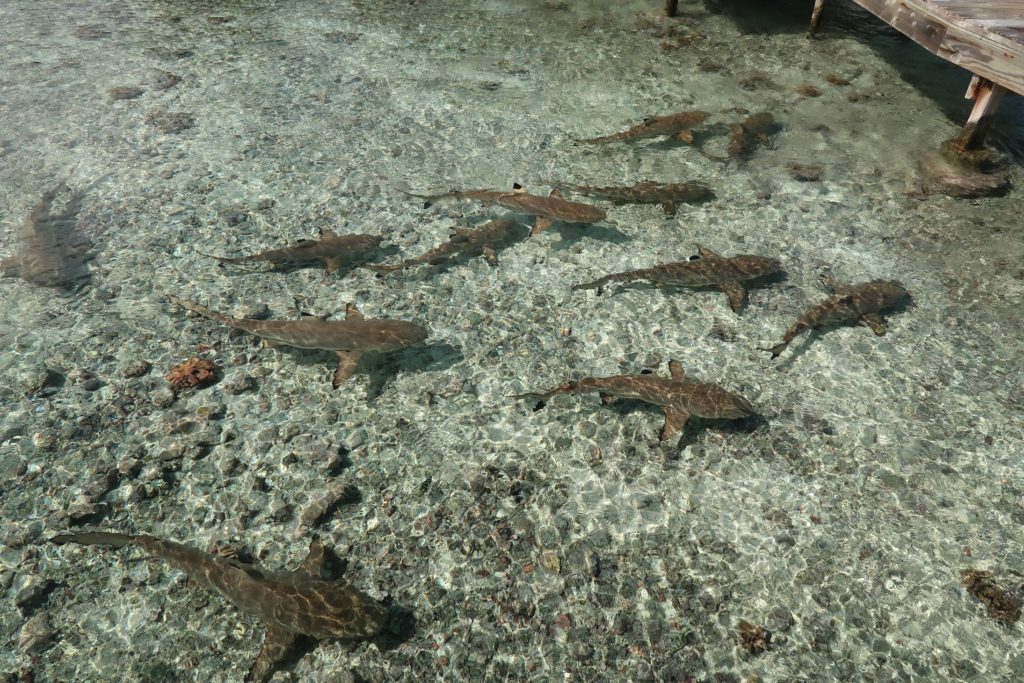
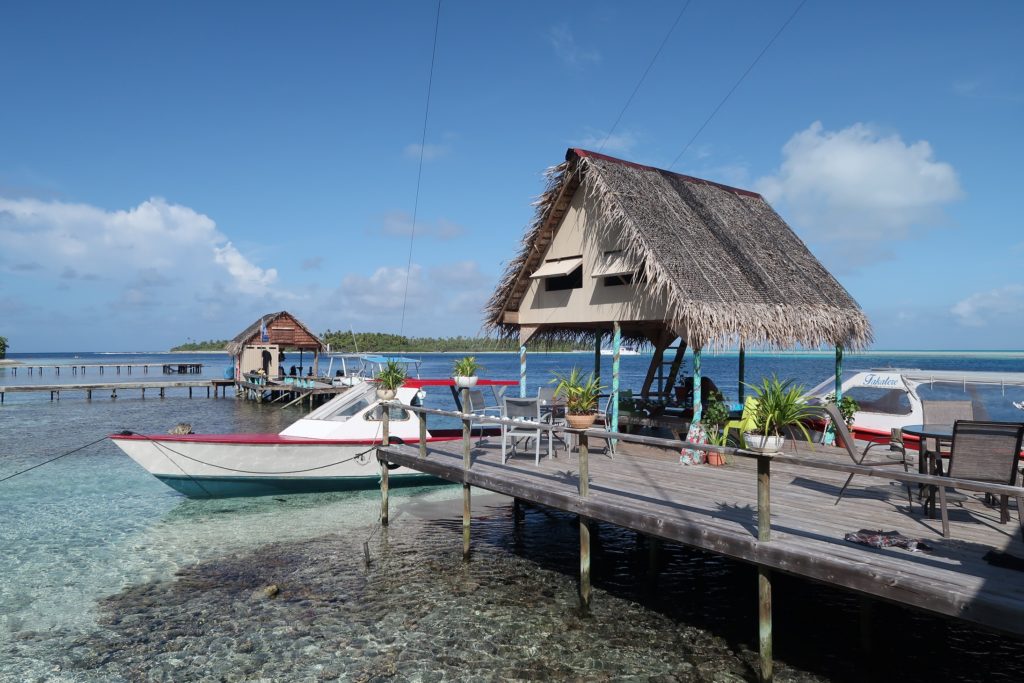 The experience of diving in the pass was breathtaking. There were numerous colourful fish of all shapes and sizes and the ugly brown spotted groupers with fearsomely sharp teeth who seemed completely unfazed by us swimming right up close to them. Most amazing was the hundreds of sharks swimming slowly against the current as if suspended, and although we were warned not to swim right amongst them we were within a few feet, clinging onto the rocks to prevent being swept along by the current. It was a very surreal experience but not at all scary. The sharks just ignored us gawping tourists and it is almost unknown for divers to be attacked by them here, though we heard that in some of the other islands they are not quite so harmless.
The experience of diving in the pass was breathtaking. There were numerous colourful fish of all shapes and sizes and the ugly brown spotted groupers with fearsomely sharp teeth who seemed completely unfazed by us swimming right up close to them. Most amazing was the hundreds of sharks swimming slowly against the current as if suspended, and although we were warned not to swim right amongst them we were within a few feet, clinging onto the rocks to prevent being swept along by the current. It was a very surreal experience but not at all scary. The sharks just ignored us gawping tourists and it is almost unknown for divers to be attacked by them here, though we heard that in some of the other islands they are not quite so harmless.
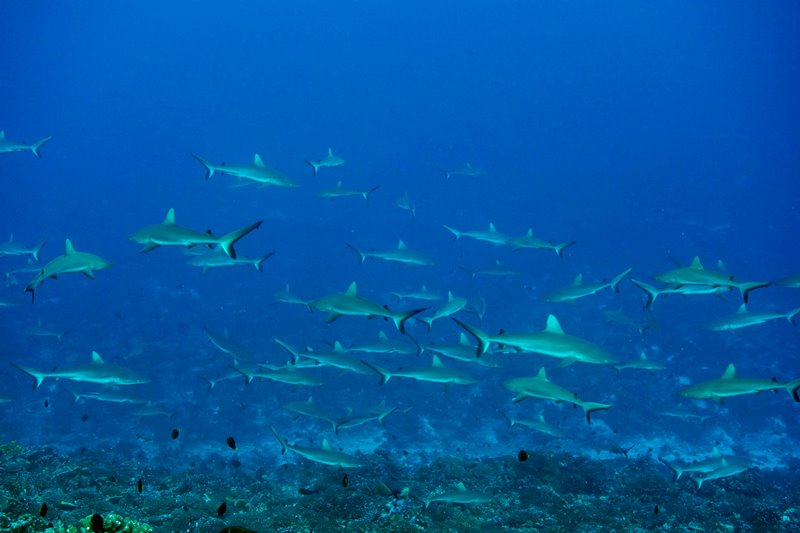

The election results in the UK are surprising…. We are delighted at the shift in opinion back home. After a couple of nights we moved along to Hirifa on the south east of the atoll where Liza and her husband live with their dogs and pet pig, and have a small restaurant on the beach. There are four things on the menu. Steak, chicken, fish and lobster. Some nights they have several guests to eat, often none – it all depends on how many yachts are at anchor. We eat at the restaurant one night and are the only guests. 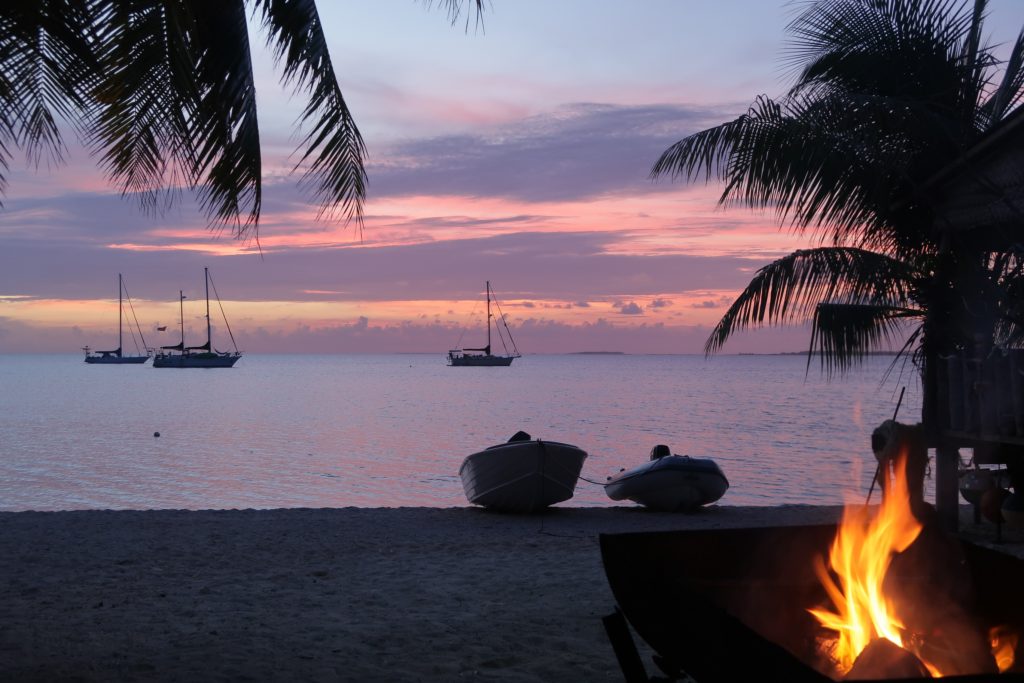 We think this is paradise too – clear turquoise water, warm seas, coconut palms – but wonder what it would be like to live here. Liza says she loves her life. She is a big, warm, laughing, joyous woman who embraces you in a big bear hug. As well as the restaurant she and her husband live by harvesting copra from the coconuts on their motu. The next morning we go to see them where they are working in their coconut plantation and have a go at chopping coconuts in half… not as easy as it looks.
We think this is paradise too – clear turquoise water, warm seas, coconut palms – but wonder what it would be like to live here. Liza says she loves her life. She is a big, warm, laughing, joyous woman who embraces you in a big bear hug. As well as the restaurant she and her husband live by harvesting copra from the coconuts on their motu. The next morning we go to see them where they are working in their coconut plantation and have a go at chopping coconuts in half… not as easy as it looks. 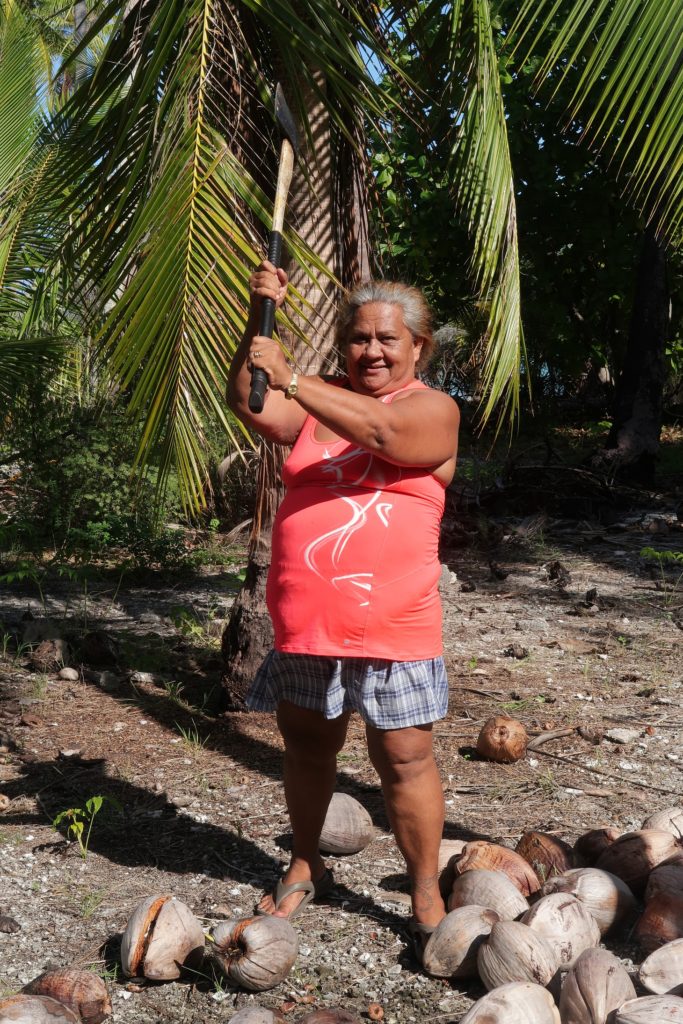
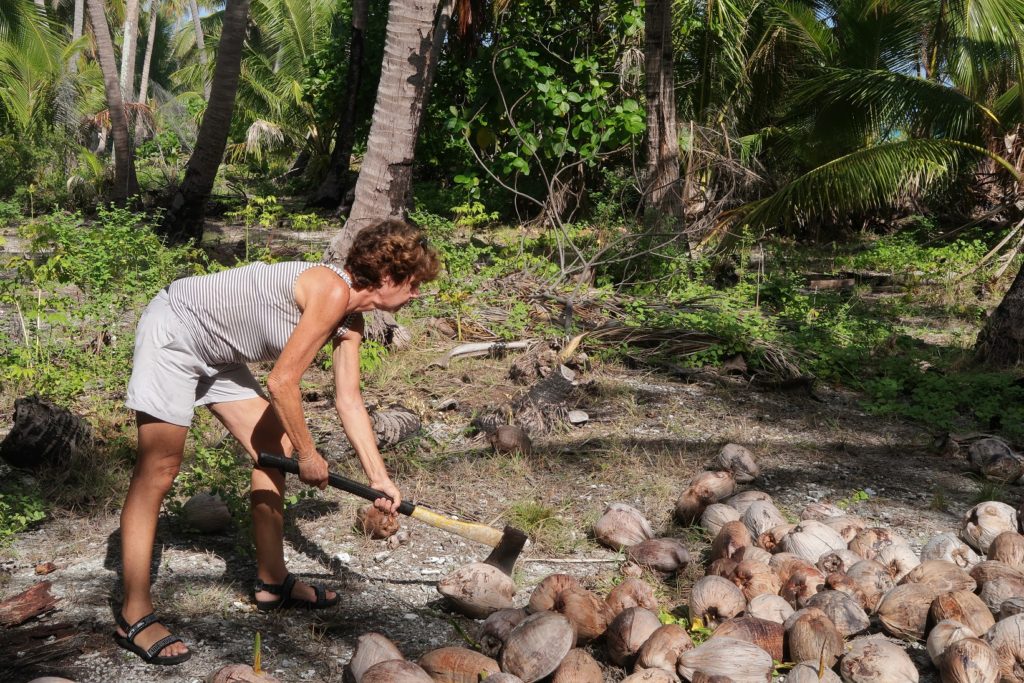
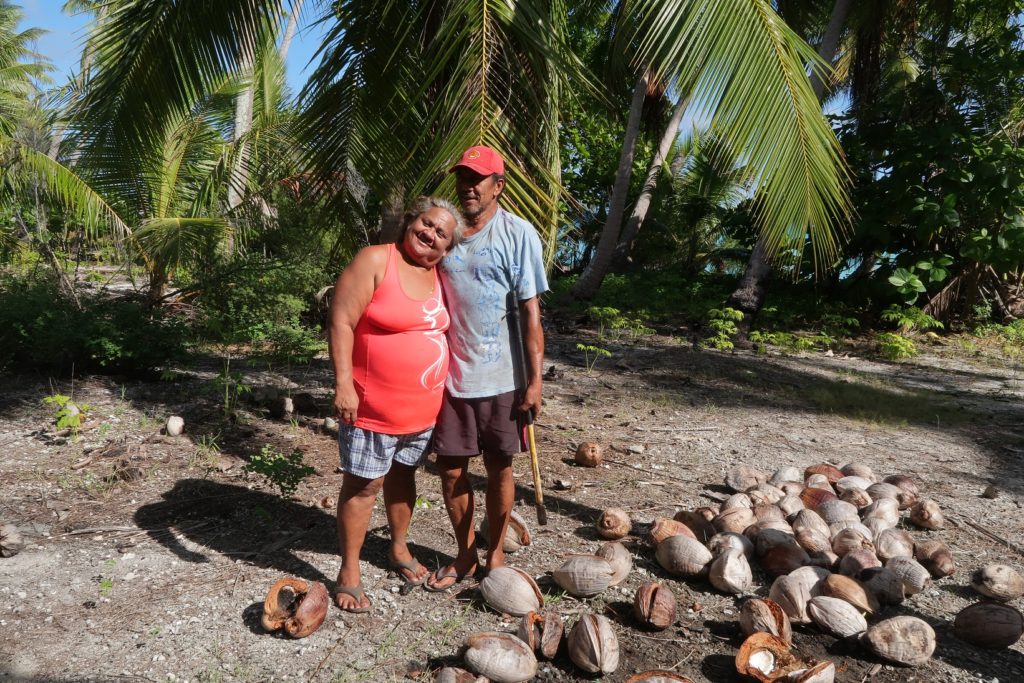 The fallen green coconuts are split in half with an axe, the white flesh left to dry for a few days then scooped out and further dried in the sun. Every month the boat from Tahiti comes by to collect the dried copra for which they are paid US$1.40 a kilo, which earns them about $100 for 2 to 3 weeks work. The copra (coconut) oil is mostly exported to the EU for use in the cosmetics and food industries. Liza chops off the top of a coconut palm for us to drink the sweet coconut water then splits it open to break off chunks of flesh to eat. She loves coconut and is munching on it constantly. Her daughter married a French doctor who was sailing the Pacific and stopped in Fakarava and she now lives in Paris. Liza has visited her there and has also been to New Zealand where she has a friend. She prefers her life here. They have a simple concrete house with a satellite disc, solar panels for power and oversized rain-butts for fresh water. The restaurant has a modern looking oven, large fridge and freezer.
The fallen green coconuts are split in half with an axe, the white flesh left to dry for a few days then scooped out and further dried in the sun. Every month the boat from Tahiti comes by to collect the dried copra for which they are paid US$1.40 a kilo, which earns them about $100 for 2 to 3 weeks work. The copra (coconut) oil is mostly exported to the EU for use in the cosmetics and food industries. Liza chops off the top of a coconut palm for us to drink the sweet coconut water then splits it open to break off chunks of flesh to eat. She loves coconut and is munching on it constantly. Her daughter married a French doctor who was sailing the Pacific and stopped in Fakarava and she now lives in Paris. Liza has visited her there and has also been to New Zealand where she has a friend. She prefers her life here. They have a simple concrete house with a satellite disc, solar panels for power and oversized rain-butts for fresh water. The restaurant has a modern looking oven, large fridge and freezer. 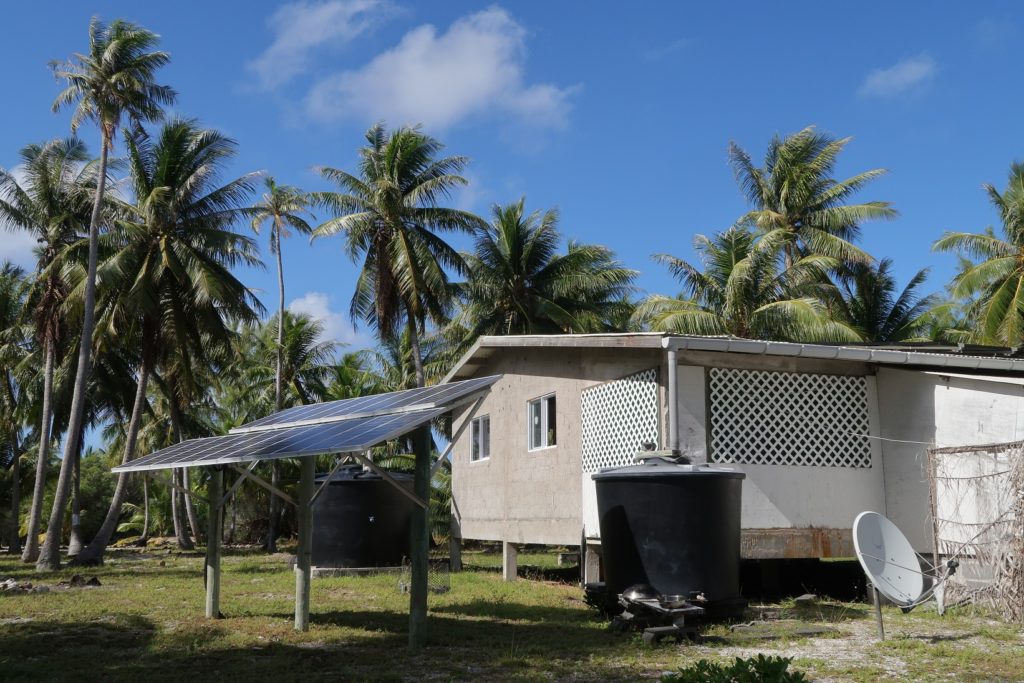 The season for visiting yachts is from April to October when they work hard. If there is a cyclone they just retreat into their house and wait for it to pass. She tells us that that there are high rates of cancer in the Tuamotus due to the French nuclear testing. This took place in two of the more southerly atolls between 1966 and 1996 and we recall there being much international protest at the time, particularly from New Zealand, and that French agents bombed and sank the Greenpeace ship, Rainbow Warrior, in Auckland Harbour in 1985. We made our way up the east side of the lagoon, stopping half way up to anchor for two nights by the Pakokota yacht club where a young Polynesian couple have enterprisingly set up a service for passing yachts, including providing reasonable wifi, which we have been starved of since leaving the Marquesas. Whilst here we discover that some of our bags of pasta and rice have become infested with weevils, and spend a day cleaning cupboards, checking bags and throwing anything overboard that shows signs of the little brown beetles. We were told that the weekly supply ship from Tahiti arrives in Rotoava on a Wednesday and to arrive in time to buy leaks, oranges, tomatoes, carrots, papaya, and aubergine at Sophie’s vegetable shop. Few if any vegetables are grown in the Tuamotus and some of the vegetables are from the USA and New Zealand, as well as Tahiti.
The season for visiting yachts is from April to October when they work hard. If there is a cyclone they just retreat into their house and wait for it to pass. She tells us that that there are high rates of cancer in the Tuamotus due to the French nuclear testing. This took place in two of the more southerly atolls between 1966 and 1996 and we recall there being much international protest at the time, particularly from New Zealand, and that French agents bombed and sank the Greenpeace ship, Rainbow Warrior, in Auckland Harbour in 1985. We made our way up the east side of the lagoon, stopping half way up to anchor for two nights by the Pakokota yacht club where a young Polynesian couple have enterprisingly set up a service for passing yachts, including providing reasonable wifi, which we have been starved of since leaving the Marquesas. Whilst here we discover that some of our bags of pasta and rice have become infested with weevils, and spend a day cleaning cupboards, checking bags and throwing anything overboard that shows signs of the little brown beetles. We were told that the weekly supply ship from Tahiti arrives in Rotoava on a Wednesday and to arrive in time to buy leaks, oranges, tomatoes, carrots, papaya, and aubergine at Sophie’s vegetable shop. Few if any vegetables are grown in the Tuamotus and some of the vegetables are from the USA and New Zealand, as well as Tahiti. 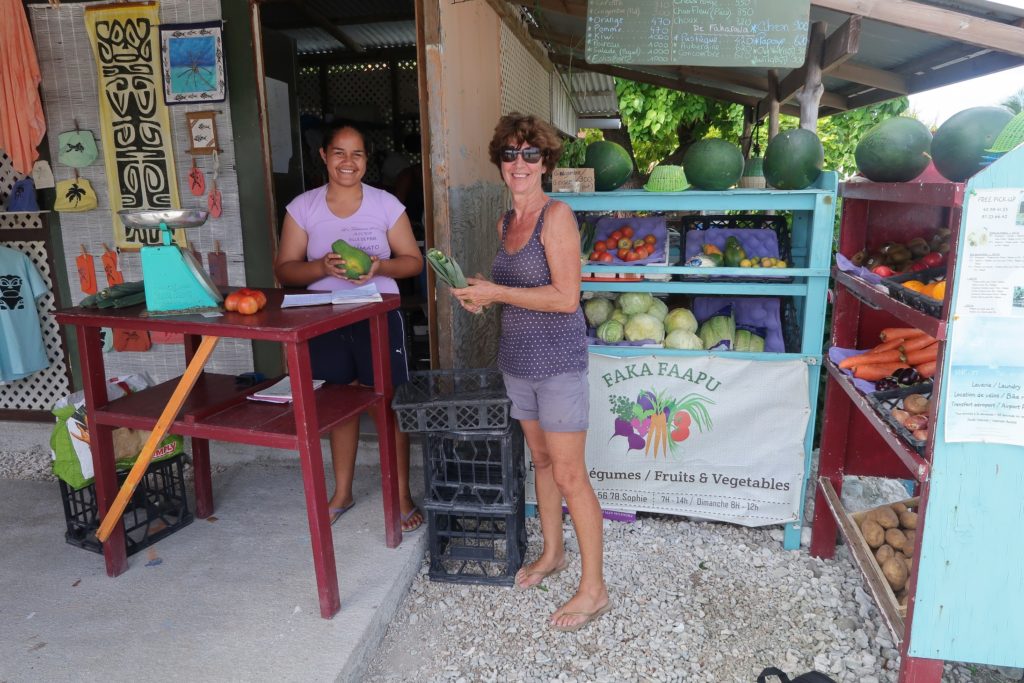 There are several pearl farms here and we hired bicycles to visit a small one, owned by a German architect who met his Polynesian wife whilst working in Tahiti. They are both now elderly and he gets around on a zimmer, but he speaks good English and showed us how a plastic seed core is inserted into the reproductive sac in an oyster which is then suspended in a basket in the lagoon for 18 months. The ‘black’ pearls that develop are in fact all shades of colour from grey to green through aubergine and purple to black.
There are several pearl farms here and we hired bicycles to visit a small one, owned by a German architect who met his Polynesian wife whilst working in Tahiti. They are both now elderly and he gets around on a zimmer, but he speaks good English and showed us how a plastic seed core is inserted into the reproductive sac in an oyster which is then suspended in a basket in the lagoon for 18 months. The ‘black’ pearls that develop are in fact all shades of colour from grey to green through aubergine and purple to black. 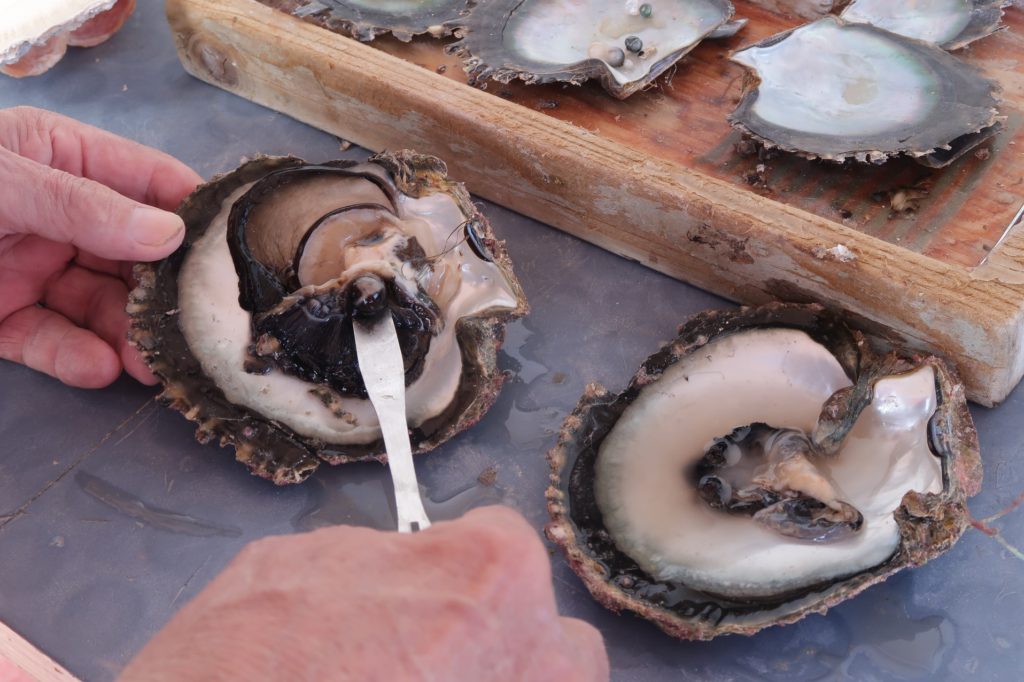
We meet up again in Fakarava with Keith, Renee and their kids on Zatara who we got to know in the Marquesas and with Angela and Reto on their catamaran SheSan, who we first met nine months ago in Bonaire and then again in Santa Marta in Colombia. We share meals on board and a morning yoga session on the beach. One evening we brought along the sextants that we all have on board but that only Jacob knows how to use. He gave us a lesson on how to line up the sun and the horizon and we all promised to practice regularly. The sextant has now gone back into storage in a locker. 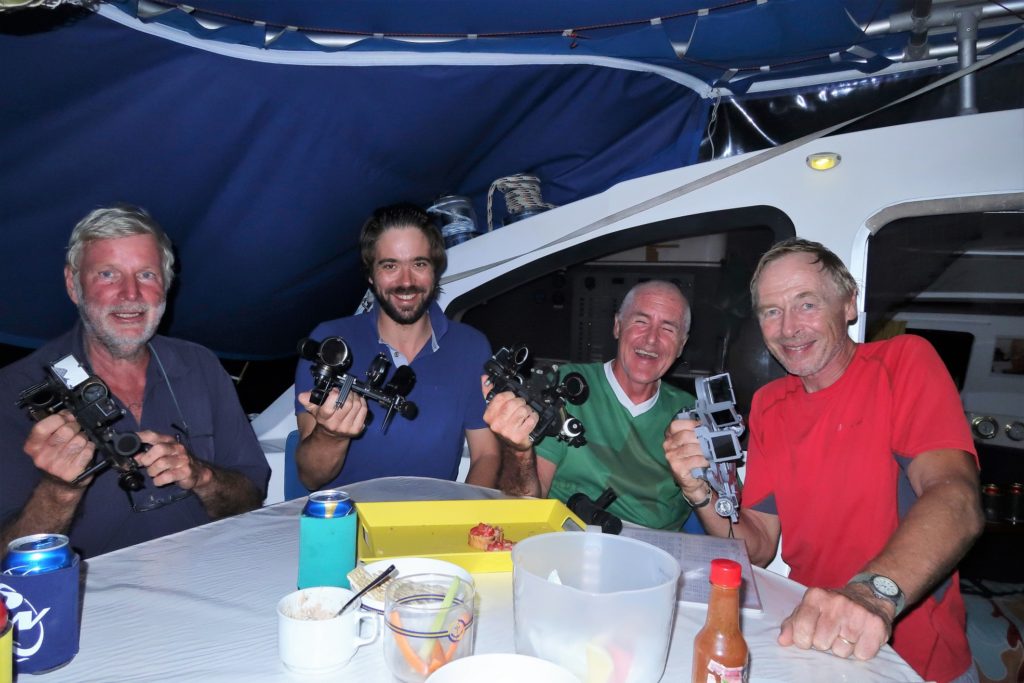 We loved Fakarava… it has stunning diving, isolated motus, a pretty town, lots of sharks and the sun shines all day, every day… but after just a couple of weeks in the Tuamotus we had to leave Fakarava through the north pass for the two day sail west to Tahiti.
We loved Fakarava… it has stunning diving, isolated motus, a pretty town, lots of sharks and the sun shines all day, every day… but after just a couple of weeks in the Tuamotus we had to leave Fakarava through the north pass for the two day sail west to Tahiti. 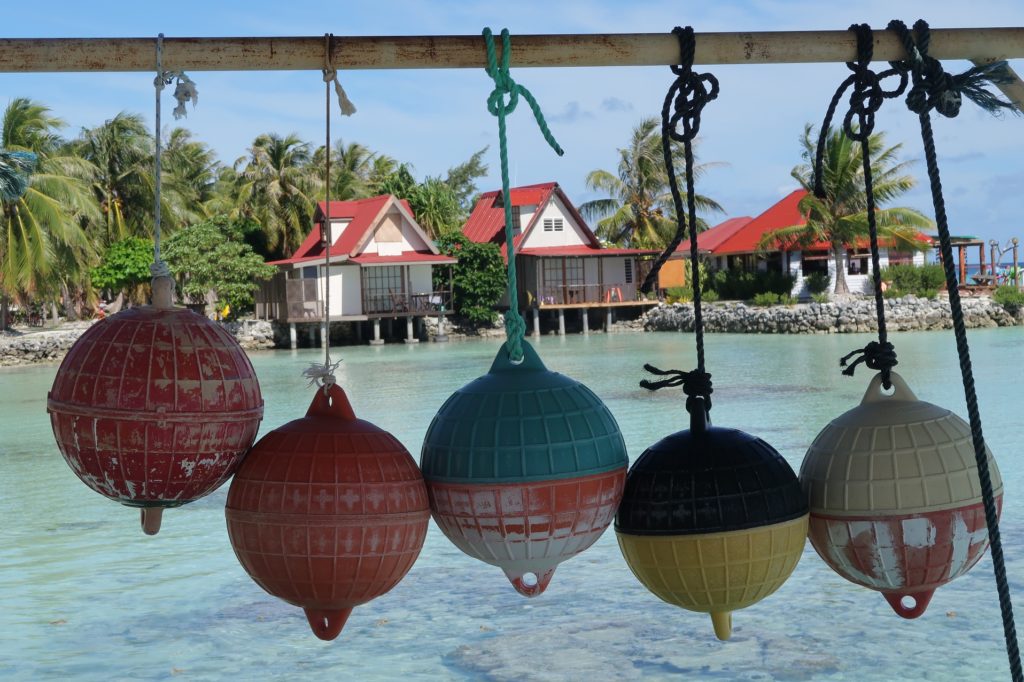
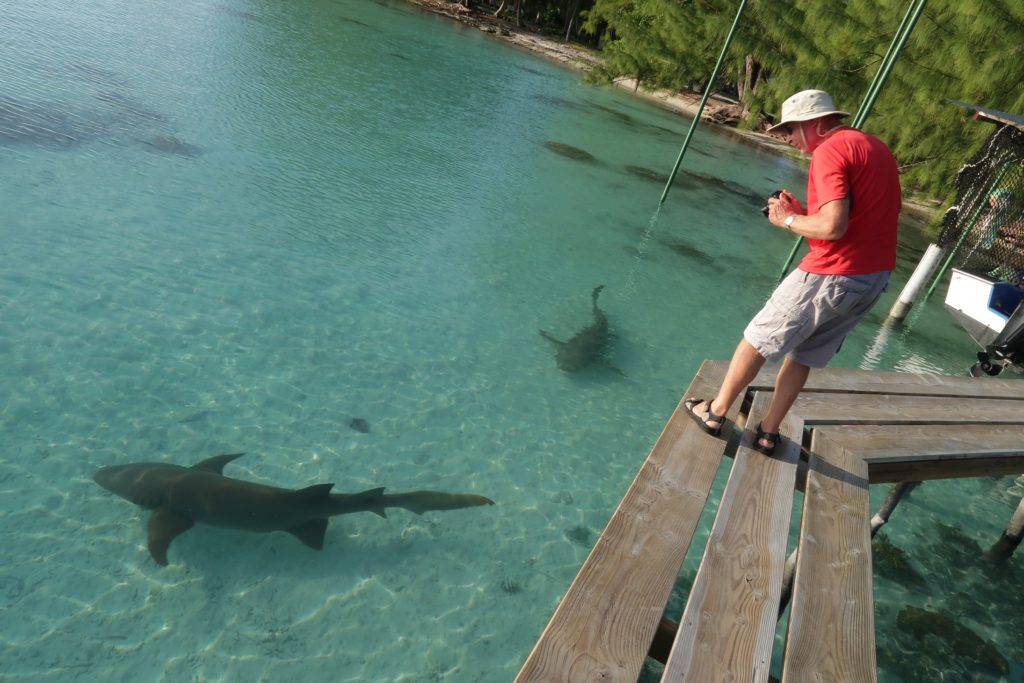
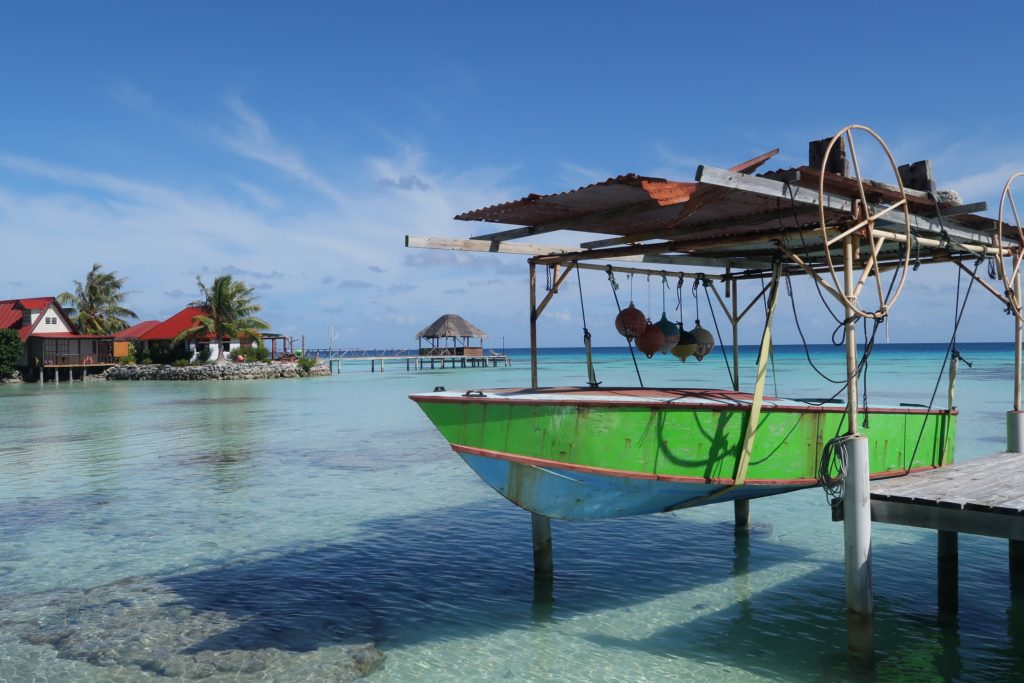
4 Comments
The Jetski
July 23, 2017 - 11:40 pmIt all looks so lovely. You seem very brave with all those sharks though! We’ve had some half decent weather here but currently back to cloud and rain I’m afraid. Look forward to the next update
Take care
annie
July 29, 2017 - 10:05 pmFortunately the sharks seem more eager to avoid us xx
Paul McLoughlin
July 27, 2017 - 10:45 amStunning location…enjoy
Paul
annie
July 29, 2017 - 10:04 pmThanks Paul…. We’ll do our best! xx